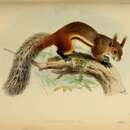en
names in breadcrumbs


Idiurus macrotis produce a mouse-like squeak. Its primary function is not known.
Perception Channels: visual ; tactile ; acoustic ; chemical
Idiurus macrotis is considered a lower risk, but near threatened species on the IUCN redlist. Habitat loss due to deforestation is considered the largest threat to this species.
CITES: appendix iii
IUCN Red List of Threatened Species: least concern
Little information is available on the impact this species has on its ecosystem. Idiurus macrotis may disperse the seeds of the fruit it eats, and may damage trees by eating bark.
Ecosystem Impact: disperses seeds
Stomach contents of specimens indicate that they are mostly frugivorous. Also, some bark peeling and ingestion of phloem sap has been observed, but little else is known about their feeding habits.
Plant Foods: wood, bark, or stems; fruit; sap or other plant fluids
Primary Diet: herbivore (Frugivore , Lignivore, Eats sap or other plant foods)
Idiurus macrotis is native to southern Cameroon and Eastern Zaire, and the Bwamba forests in Uganda.
Biogeographic Regions: ethiopian (Native )
Idiurus macrotis inhabits dense tropical forests. This species is almost completely arboreal. Individuals spend days sleeping in the hollows of large trees and nights gliding from one tree to the next.
Habitat Regions: tropical
Terrestrial Biomes: forest ; rainforest
The lifespan is not known. They cannot survive for any significant time in captivity.
Idiurus macrotis is named for one of its remarkable characteristics, idios being Greek for ‘peculiar’ and oura meaning ‘tail’. The tail is longer than the head and body and is made feather-like in appearance by both long, widely spaced hairs and short, dense hairs that project laterally, almost perpendicular to the length of the tail. The hairless areas on the dorsal and ventral sides of the tail are scaly, and there are large horny scales present near the body. The tail may assist in gripping trees as well as balancing the animal.
The total length of I. macrotis is 208 to 220 mm and it weighs 25 to 35g. The pelage is short and dense and has a soft texture. The individual hairs are dark grey at the base and pale at the tips, with no patterns or color variation. The gliding membrane is also hairy. It extends between the hind- and forelimbs, with a small section connecting the wrist and neck and another enclosing a short portion of the tail and neck. The feet are covered with dark grey bristles and the claws are not very developed. The whiskers are long and black.
Range mass: 25 to 35 g.
Range length: 208 to 220 mm.
Average length: 208 mm.
Sexual Dimorphism: male larger
Other Physical Features: endothermic ; bilateral symmetry
Almost nothing is known about the reproduction of Idiurus macrotis.
Almost nothing is known about their breeding habits. They have been captured and found to be pregnant in June and August.
Key Reproductive Features: gonochoric/gonochoristic/dioecious (sexes separate); sexual ; viviparous
There is almost nothing known about the parental investment of Idiurus mactotis. It can be inferred that like all mammals, females nurse their young and therefore provide at least some care.
Parental Investment: pre-hatching/birth (Provisioning: Female); pre-weaning/fledging (Provisioning: Female)
The long-eared flying mouse (Idiurus macrotis) or long-eared scaly-tailed flying squirrel, is a species of flying mouse from western and central Africa.[1][2][3]It is not actually a squirrel, nor a mouse, though it is a rodent.[4] Not much is known about them because they are very hard to keep alive in captivity.[4]
To achieve gliding flight, it uses two membranes (patagia) which fold up when not in use. When the limbs are stretched wide in a star-shape, the membranes become taut and allow the rodent to glide from tree to tree. Being arboreal, Idiurus spends all of its time in the trees, living in hollow trunks in groups of 2 to 40.[4] Limit information suggests that it is mainly frugivorous.[4] It has a long tail in proportion to its body, sporting two lines of raised scales, and patches of scaly skin to help it grip trees, but the rest of its body is furry. The tail is longer than the body and is also used to balance, like a primate's tail. Long-eared scaly-tailed flying squirrels are about 20 cm long and weigh 30g. In comparison, the body of a common household mouse is approximately 10 cm long and its tail is approximately 5 cm.
The long-eared flying mouse (Idiurus macrotis) or long-eared scaly-tailed flying squirrel, is a species of flying mouse from western and central Africa.It is not actually a squirrel, nor a mouse, though it is a rodent. Not much is known about them because they are very hard to keep alive in captivity.
To achieve gliding flight, it uses two membranes (patagia) which fold up when not in use. When the limbs are stretched wide in a star-shape, the membranes become taut and allow the rodent to glide from tree to tree. Being arboreal, Idiurus spends all of its time in the trees, living in hollow trunks in groups of 2 to 40. Limit information suggests that it is mainly frugivorous. It has a long tail in proportion to its body, sporting two lines of raised scales, and patches of scaly skin to help it grip trees, but the rest of its body is furry. The tail is longer than the body and is also used to balance, like a primate's tail. Long-eared scaly-tailed flying squirrels are about 20 cm long and weigh 30g. In comparison, the body of a common household mouse is approximately 10 cm long and its tail is approximately 5 cm.